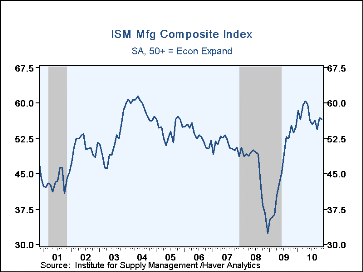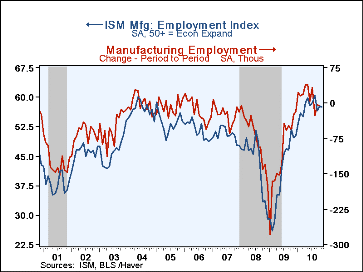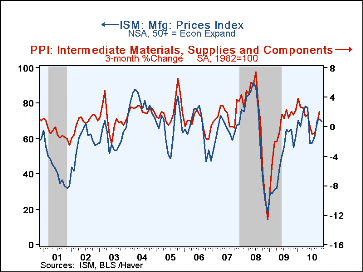 Global| Dec 01 2010
Global| Dec 01 2010U.S. ISM Factory Sector Index Slips But Indicates Positive Growth
by:Tom Moeller
|in:Economy in Brief
Summary
Expansion in factory sector activity continued during November, as indicated by the Composite Index from the Institute for Supply Management. It slipped to 56.6 from 56.9 in October but the latest was the highest level since May. The [...]
Expansion in factory sector activity continued during November, as indicated by the Composite Index from the Institute for Supply Management. It slipped to 56.6 from 56.9 in October but the latest was the highest level since May. The figure roughly matched Consensus expectations for 56.5. The latest level was the sixteenth consecutive figure above the break-even 50 and was up from the low of 32.5 reached in December '08. (Any figure above the break-even point of 50 suggests rising activity.) The ISM data is available in Haver's USECON database.
Weaker readings for production and new orders accounted for most of the m/m decline in the total index. Production fell sharply to its lowest level of the economic recovery as just 26 percent of firms reported higher production versus 37 percent in October. The orders index followed with a modest 2.3 point decline. Thirty percent of firms reported higher orders. The employment index held roughly stable at 57.5, its twelfth consecutive month above 50. During the last ten years there has been a 90% correlation between the index level and the m/m change in factory sector employment. At the back-end of factory sector activity both the supplier delivery and the inventories indexes rose, the latter to its highest since 1985.
Also falling was the export order index to 57.0. During the last ten years there has been an 88% correlation between the level of the index and the quarterly change in merchandise exports. A lessened twenty-three percent of respondents reported higher export orders while nine percent reported orders lower.
The separate index of prices paid fell to 69.5, its lowest since June and it remained down from the April high of 78.0 but up from the December '08 low of 18.0. Forty-eight percent of respondents reported higher prices while nine percent indicated lower prices. During the last twenty years there has been an 83% correlation between the price index and the three-month change in the PPI for intermediate goods.
The ISM data are available in Haver's USECON database.
| ISM Mfg | November | October | September | Nov.'09 | 2009 | 2008 | 2007 |
|---|---|---|---|---|---|---|---|
| Composite Index | 56.6 | 56.9 | 54.4 | 53.7 | 46.2 | 45.5 | 51.1 |
| New Orders | 56.6 | 58.9 | 51.1 | 61.5 | 51.6 | 42.1 | 54.3 |
| Employment | 57.5 | 57.7 | 56.5 | 49.6 | 40.5 | 43.3 | 50.5 |
| Production | 55.0 | 62.7 | 56.5 | 60.2 | 50.4 | 45.2 | 54.1 |
| Supplier Deliveries | 57.2 | 51.2 | 52.3 | 55.7 | 51.4 | 51.6 | 51.2 |
| Inventories | 56.7 | 53.9 | 55.6 | 41.4 | 37.1 | 45.5 | 45.4 |
| Prices Paid Index (NSA) | 69.5 | 71.0 | 70.5 | 55.0 | 48.3 | 66.5 | 64.6 |
Tom Moeller
AuthorMore in Author Profile »Prior to joining Haver Analytics in 2000, Mr. Moeller worked as the Economist at Chancellor Capital Management from 1985 to 1999. There, he developed comprehensive economic forecasts and interpreted economic data for equity and fixed income portfolio managers. Also at Chancellor, Mr. Moeller worked as an equity analyst and was responsible for researching and rating companies in the economically sensitive automobile and housing industries for investment in Chancellor’s equity portfolio. Prior to joining Chancellor, Mr. Moeller was an Economist at Citibank from 1979 to 1984. He also analyzed pricing behavior in the metals industry for the Council on Wage and Price Stability in Washington, D.C. In 1999, Mr. Moeller received the award for most accurate forecast from the Forecasters' Club of New York. From 1990 to 1992 he was President of the New York Association for Business Economists. Mr. Moeller earned an M.B.A. in Finance from Fordham University, where he graduated in 1987. He holds a Bachelor of Arts in Economics from George Washington University.










